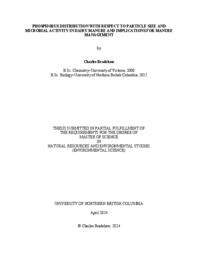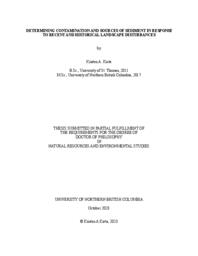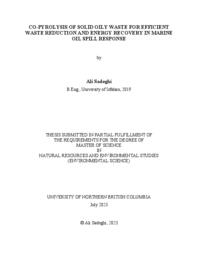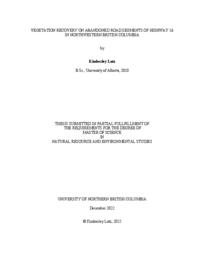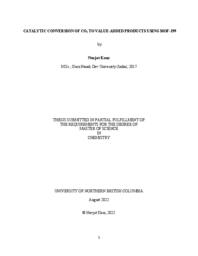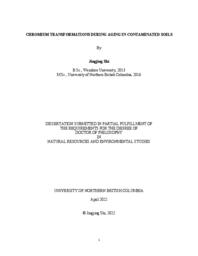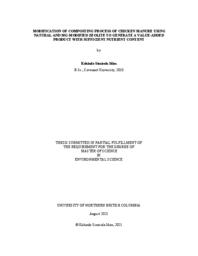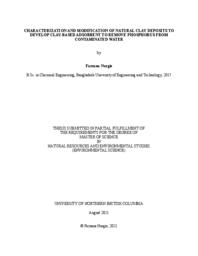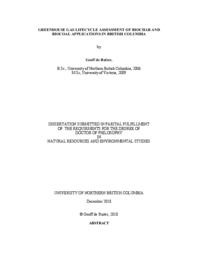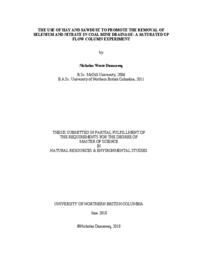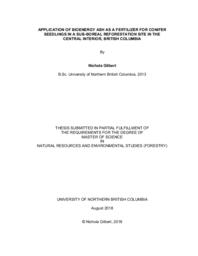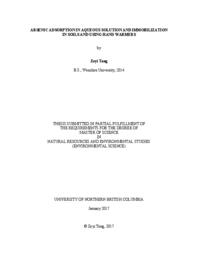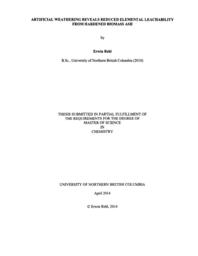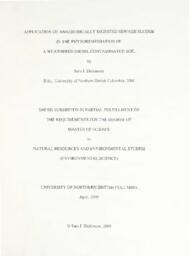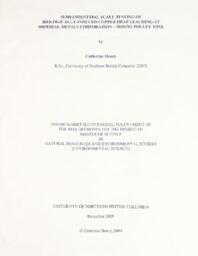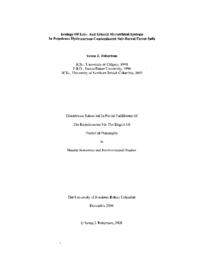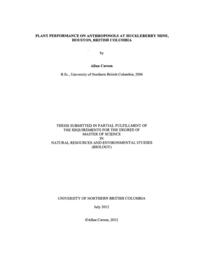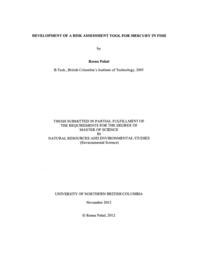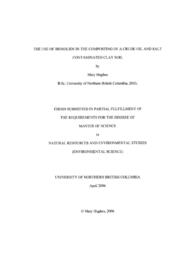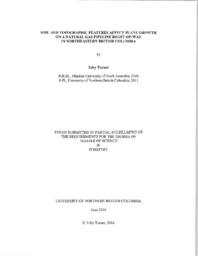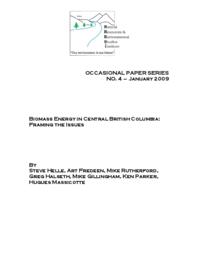Rutherford, Michael
Person Preferred Name
Michael Rutherford
Related Works
Content type
Digital Document
Description / Synopsis
This work investigated the distribution of phosphorus in dairy manure as it relates to particle size and provides experimentally derived insights for improving the management of phosphorus. The data presented here illustrates some aspects of manure handling that may be optimized for controlling the distribution of phosphorus. It provides experimental data that supplements existing literature by 1) extending the limits of study regarding particle size distribution; 2) extending the limit of centrifugal forces studied; 3) demonstrating an improved pathway for phosphorus management in wastewater using a substrate mediated flocculation process; and 4) providing some experimental observations showing that the microbiota present in dairy manure can diminish stratification of suspended solids and phosphorus concentrations within separated liquid manure products. Further, based on quadratic modeling of phosphorus relative to sieve size, and the observations that accompanied progressive washing and mechanical agitation performed, a convincing argument for relating phosphorus distribution to the surface area of a substrate is made. The findings imply that much of the phosphorus present in manure is superficially bound to larger particulates, rather than an intrinsic or chemical part of the bulk material itself, and can be mediated by washing or mechanical means where the phosphorus present in coarser fractions can be shunted towards finer or liquid fractions. Approximately 80% of phosphorus was associated with particulates bound to larger substrate. Indeed, 95.5% of the phosphorus in the bulk manure was removable as particulates with cross sectional diameter less than 2mm by simple washing. Further removal of phosphorus in >2mm substrate through fermentation and leaching was also demonstrated. Some portion of this distribution in phosphorus appears to be dominated by microbes.
Origin Information
Content type
Digital Document
Description / Synopsis
Landscape level disturbances occur in nearly every watershed throughout the globe, and as the climate changes, these disturbances will continue to have a significant impact on terrestrial and aquatic ecosystems. Wildfire, timber harvesting, and agricultural expansion are only a few of these disturbances, but each uniquely impacts the sediment regime. While sediment is a necessary and beneficial input to streams and rivers, it also can have negative impacts on the aquatic ecosystem because it can carry contaminants and also be physically detrimental when it settles, clogging spawning habitat. All of these disturbances have occurred historically and in the present in the Nechako River Basin (NRB), a large, regulated watershed in north-central British Columbia, Canada. In the NRB, chinook and sockeye salmon and the Nechako White Sturgeon are species that have been declining in population, in part due to the clogging of their habitat by sand and fine sediment. One way to determine sources of sediment is by using the sediment fingerprinting technique, whereby sediment samples and samples from potential sources are collected and analyzed for a series of physical or biogeochemical properties, and the proportion of sediment coming from each potential source is identified using an unmixing model. After catastrophic wildfires in 2018, research was undertaken to determine the spatial and temporal contamination of soils and sediment by polycyclic aromatic hydrocarbons (PAHs), to determine if burned areas were contributing more sediment than unburned areas to tributaries and the Nechako River mainstem, and to determine the suitability of PAHs as a novel fingerprint. The results found that concentrations of PAHs in the burned soils were elevated immediately post-wildfire, but decreased significantly in subsequent years, and concentrations in sediments were very low. While PAHs were deemed to be non-conservative properties, unmixing modeling using colour showed that burned sources were an important contributor to the tributaries, but less so in the mainstem Nechako River. Agriculture is an important and growing industry in the NRB and is also an important source of sediment. Results from fingerprinting research undertaken in Murray Creek, an important watershed due to its proximity to spawning habitat, found that agriculture was the primary source of sediment in the basin, though channel banks were also important. While the intention was to use compound specific stable isotopes of long chain fatty acids to more specifically pinpoint agricultural fields that were contributing more sediment to the watershed, this semi-novel tracer was unable to discriminate between C3 plant types on a large scale. Taking the entire disturbance regime of the NRB into account, a broader scale fingerprinting study found that sources of sediment are tributary specific, though banks and agriculture were consistently most important. This study also identified that the predicted shift to a rain dominated watershed and earlier freshet will lead to increased potential for erosion from various sources, and that increased incidence of wildfire followed by heavy precipitation may increase sediment loads. Therefore, a number of management changes are suggested, including improving farming practices, post-wildfire landscape rehabilitation, and altering water release practices.
Origin Information
Content type
Digital Document
Description / Synopsis
Despite substantial advances in cleaning up marine spills, solid oily waste generation during a spill is an inevitable problem that could easily exceed the capacity of locally available waste management facilities. This thesis developed a pyrolysis system to cope with multiple oily solid waste streams simultaneously. The treatment of contaminated sorbent through co-pyrolysis with Personal Protective Equipment (PPE) that are two types of solid oily waste in marine oil spill response was carried out in a heating mantle system over temperature and heating rate ranges of 350 to 550 °C and 5 to 20 °C/min, respectively. Response surface method was applied to evaluate the main and interaction effects of three experimental factors (contaminated sorbent ratio in feedstock, heating rate, and temperature) on pyrolysis oil and gas yields. It was found that gas yield decreased while the oil yield increased with raising the contaminated sorbent percentage in feedstock. Total weight loss as high as 99.6% (liquid; 96.8%, gas; 2.8%, and char; 0.4%) and 84.4% (liquid; 77.4%, gas; 7.0%, and char; 15.6%) was achieved at the contaminated sorbent ratios of 100% and 80%, respectively. The oil yield value of 98.1% under optimal experimental conditions (temperature; 460 °C, heating rate; 5 °C /min, and contaminated sorbent ratio; 99%) with 1% error compared to the predicted value of 97.1% validated the model. The oil obtained through co-pyrolysis at a contaminated sorbent ratio of 75% exhibited a Higher Heating Value (HHV) of 43.67 MJ/Kg, thereby suggesting its potential as an energy source. As a result, multiple types of solid oily waste can be treated through the co-pyrolysis process to produce energy-rich products, reduce the amount of waste, recover spilled hydrocarbons, and improve energy recovery.
Origin Information
Content type
Digital Document
Description / Synopsis
Vegetation recovery on abandoned road segments of Highway 16 in northwestern British Columbia were examined across a climate gradient. The time since road abandonment ranged from 16 to 57 years on sites sampled. Plant cover on asphalt roads was compared with that found on gravel road shoulders using paired t-tests. Plant cover by growth form was further evaluated in response to climate and other environmental predictor variables using multiple regression ‘best fit’ models. Plant community ordination analysis using nonmetric multidimensional scaling was conducted to describe patterns across study sites in species space along environmental gradients. Key drivers of current plant community composition include time since road abandonment, road substrate type, and several different annual climate variables. The best predictor of vascular plant cover and total plant cover was time since road abandonment, but plant community composition was strongly driven by the coastto-interior climate gradient. Non-vascular cover was more abundant on asphalt roads compared to gravel substrates. Woody plant cover was greatest on gravel shoulders compared to gravel or asphalt road centers. Exotic plant cover was negatively correlated with mean annual relative humidity. Plant diversity and species richness were not driven by the climate gradient but instead reflected more site-specific environmental variables. Primary succession on abandoned roads in this study area may be constrained by continued anthropogenic disturbance post-abandonment.
Origin Information
Content type
Digital Document
Description / Synopsis
With the increase in carbon dioxide emissions into the environment, there is an increased need to capture carbon dioxide (CO2). One method of removal of CO2 that has been receiving more attention is its conversion to useful chemicals. Metal organic frameworks (MOFs) are promising candidates in catalysis because of their remarkable properties such as great surface area, high stability, active sites, porosity, tunability and affinity for CO2. In this study metal organic framework i.e., MOF-199, developed by solvothermal and evaporation-induced self-assembly (EISA) techniques, was used to catalyze the reaction between CO2 and epoxides such as propylene oxide (EP1), styrene oxide (EP2), epichlorohydrin (EP3), and 1,2-epoxybutane (EP4). The corresponding carbonates are obtained by using tetrabutylammonium bromide (TBAB) as a co-catalyst. The synthesized MOF-199 was characterized by X-ray diffraction, Fourier transform infrared spectroscopy, thermal gravimetric analysis, scanning electron microscopy, and Brunauer-Emmett-Teller analysis. More than 65% conversion of epoxides (EP1, EP2, EP3, and EP4) to their corresponding carbonates were obtained under mild reaction conditions (100°C and 70 psi) over the synthesized MOF-199 catalysts (1S, 2E, 3E, and 4E), and co-catalyst (TBAB). The percentage yields of cyclic carbonates were determined by using 1H-NMR spectroscopy. The synthesized MOF catalysts demonstrated the high catalytic activity for the chemical fixation of CO2 to cyclic carbonates at mild reaction conditions.
Origin Information
Content type
Digital Document
Description / Synopsis
Extensive industrial activities have led to Cr contamination in the environment, which poses threats to ecosystems and human health. Currently, very little is known regarding the Cr accumulation in soils during aging. The purpose of this dissertation was (i) to enhance our understanding of Cr transformations occurring over a long period of time; (ii) to investigate the reduction of toxic Cr(VI) to non-toxic Cr(III) by soil microorganisms for developing bioremediation strategies for Cr-contaminated sites. Soil samples were collected from a longterm (> 30 years) tannery waste contaminated area in Shuitou (China) for this research. Chemical extraction methods showed the Cr(III) form was dominant (> 96.7% of total Cr) in these aged Cr-contaminated soils, with toxic Cr(VI) up to 144 mg kg-1. Of the total Cr(VI) present, immobile Cr(VI) represented > 90%. Synchrotron-based X-ray near edge structure spectroscopy demonstrated Cr species present were CrFeO3, CrOOH, and CaCrO4. The occurrence of immobile Cr(VI) species in long-term contaminated soils was further verified by a spiking experiment over 240-day aerobic incubation. Available Cr(VI) in soils continually decreased during aging, with immobile Cr(VI) increasing by 4.5 – 31% and immobile Cr(III) increasing by 68 – 95% of total spiked Cr(VI). These findings reveal that Cr(VI) reduction and immobilization were occurring concurrently in soils. Cr(VI) reduction occurs in soils with low pH and high organic carbon content via both chemical and biological processes, while Cr(VI) immobilization occurs in soils with cations (such as Ca2+) and Fe oxides. Shotgun metagenomic sequencing was used to analyze the microbial community composition in the soils and a batch solution experiment was employed to determine the Cr(VI) reduction capacity by soil microbial consortia. The results demonstrated the accumulation of high levels of Cr in a soil (e.g., 3141 mg kg-1 in S3-2) led to the increased abundance of Cr resistant and reducing microorganisms: Proteobacteria (69.9%) at phylum level, Betaproteobacteria (39.1%) at class level, and Massilia (12.6%) and Bacilli (0.57%) at genus level. Batch experiment results showed the addition of 1.0 g Cr-contaminated soils reduced 10 – 20 mg L-1 Cr(VI) in 20 mL of K2Cr2O7 solution at the condition of 30 oC at pH 7.8 – 8.0 within 7 days anaerobically and aerobically, when supplied with 0.2 g L-1 of Na-acetate as carbon and electron sources. The amount of Cr(VI) removed was highest (29.0 mg L-1) at 40 mg Cr(VI) L-1 in the presence of soil S3-2. Therefore, prospective application of mixed microbial consortia from high Cr-contaminated soils for bioremediation of Cr(VI)-polluted environments could be expected.
Origin Information
Content type
Digital Document
Description / Synopsis
This research was aimed at developing a composting process of organic waste using natural and modified zeolites by ascertaining how effective they were in retaining phosphorus (P) after 60 days. The experiments included compost (C) containing natural (N) and modified (M) zeolite (Z) treatments (applied at 10% and 15% on a weight basis of the total waste): CNZ10, CNZ15, CMZ10, CMZ15 and C (which is the control treatment with no zeolite addition). The second objective was to compare the barley shoot biomass and nutrient concentration of the various compost treatments mixed with soil and control treatment (just soil) after 45 days of planting in the greenhouse. In general, the benefits of co-addition of compost and zeolite on sandy soil were tested in a completely randomized experimental design. The results indicated that the treatments with the highest zeolite treatments (CNZ15 and CMZ15) proved most effective at retaining P by the end of the composting process (2.8mg and 2.9mg respectively) compared to the lower zeolite ratios and the control treatment; CNZ10 (2.0mg), CMZ10 (1.9mg) and C (0.7mg). The barley shoot biomass results indicated that the treatments that had a combination of soil (S) and modified zeolite (SCMZ10 and SCMZ15) had biomass of 7.67g and 7.24g respectively, followed by the natural zeolite and compost treatments (SCNZ10, SCNZ15 and SC) having 6.19g, 6.38g and 5.99g respectively and were significantly different from the control treatment (S) which had the lowest biomass of 0.48g. With respect to the plant nutrient concentration, N and P were significantly higher in the control treatment (S) compared to the other treatments while K concentration was significantly highest in the compost and some of the zeolite treatments (SC, SCNZ15 and SCMZ15) compared to other treatments. These results were in line with some previous findings where zeolite was used as a soil amendment in agriculture.
Origin Information
Content type
Digital Document
Description / Synopsis
Modification of natural clays may be a useful approach to produce an effective and low-cost adsorbent to control phosphorous, which is a key factor in controlling the eutrophication of surface waters. In this study, natural clay samples were collected, characterized, modified with ZrCl4, and then their adsorption capacity for removing phosphorus from contaminated water was studied. XRD analysis showed that the natural clay consists of kaolinite, illite, and nontronite as dominant clay mineral phases. The maximum adsorption capacity of the modified clay increased from 0.493 to 11.83 mg P/g compared to the unmodified clay. The adsorption process was fast for both natural and modified samples, achieving more than 80% and 90% phosphorus removal with natural and modified samples, respectively in less than 4 hours. The adsorption data for both clays best fit the Langmuir isotherm, and the rate of phosphorus adsorption was found to follow a pseudo-secondorder kinetic model. The adsorption capacity of both adsorbents decreased with increasing pH, and for the modified clay the change was more significant. Full factorial design and response surface methodology were applied to evaluate and optimize the effects of initial P concentration, contact time, pH, and dose. From the model, the maximum P removal efficiency predicted for the synthetic solution was 91.5% and 99.9% by natural and modified clay, respectively. R2(≈0.98) indicates that the observed results fitted well with the model prediction. Similar to the batch studies, the fixed bed column study showed the developed adsorbents are efficient in removing phosphorus from water in a continuous process as well.
Origin Information
Content type
Digital Document
Description / Synopsis
Biochar, a form of black carbon produced from pyrolyzed biomass, has been touted as a product that may suppress agricultural soil emissions while also sequestering carbon. BC Biocarbon LTD, a recently established company in McBride, BC, has developed a method of producing a new product called biocoal. This biocoal is produced from a combination of crushed biochar and an organic-based binder also made from the original biomass feedstock. As their biocoal contains similar properties to fossil coal or petroleum coke, its use to reduce emissions as an energy fuel or sequestration method may be favourable to biochar’s use as a soil additive. Additionally, this biocoal may present a method of long-term carbon sequestration if buried. This dissertation assessed the greenhouse gas emissions from the production of biocoal from BC Biocarbon’s system and compared the results to wood pellet production and delivery (Project 1), coal and petroleum coke displacement (Project 2), landfilling for carbon sequestration, while also assessing biochar’s potential soil greenhouse gas reductions with added carbon sequestration (Project 3), and a regional and province-wide assessment for reducing emissions in BC using available sawmill and roadside slash residues (Project 4). Project 1 showed that when comparing biocoal made from sawmill residues to locally produced wood pellets, transportation emissions may be decreased 64% due to biocoal’s higher heating value. When comparing emissions produced for biocoal or wood pellets at gate, biocoal may show a 42% reduction in emissions or up to a 51% increase in emissions, however this is largely dependent on the data-sourced scenarios and their underlying assumptions of emissions allocation. Project 2 showed that displacing petroleum coke in cement kilns offered the largest reduction potential compared to coal applications such as electricity generation, or lead smelting. Project 3 showed that under 3 average conditions, sequestering biocoal offered greater emission reduction potential than soil applied biochar. Finally, Project 4 showed that an estimated GHG emission reduction or carbon sequestration of 28,000,00 Mg CO2e/year from current available residues, and 20,006,000 Mg CO2e/year in 10 years’ time, BC has the potential to reduce its current emissions by around 46%, and 33% in 10 years.
Origin Information
Content type
Digital Document
Origin Information
Content type
Digital Document
Origin Information
Content type
Digital Document
Origin Information
Content type
Digital Document
Origin Information
Content type
Digital Document
Origin Information
Content type
Digital Document
Origin Information
Content type
Digital Document
Origin Information
Content type
Digital Document
Origin Information
Content type
Digital Document
Origin Information
Content type
Digital Document
Origin Information
Content type
Digital Document
Origin Information
Content type
Digital Document
Description / Synopsis
"Bioenergy, or energy derived from biomass, was the predominant energy source for humans from prehistory to the mid-19th century. With on-going energy security issues, rising greenhouse-gas (GHG) levels driven by fossil fuel energy consumption and volatile natural resource prices, the biomass energy of yesterday is now being re-evaluated as the energy source for tomorrow. The technology of bioenergy production has evolved considerably in recent years, such that heat, electricity and liquid fuels for transportation can all be derived from a wide variety of biomass starting materials. Though the transformation of sunlight energy into chemical biomass energy in plants is in theory an endlessly renewable process, the way in which we manage our lands to generate this biomass energy can be degradative and unsustainable when all of the land-use values are taken into account. This paper evaluates bioenergy through the prism of sustainability, highlighting issues relating to the physical and temporal scales of the resource and impacts of its use, technological opportunities and limitations, net environmental impacts, and community concerns and needs. The geographic focus is the central interior of British Columbia, however, the issues raised in this paper will be relevant to all locations considering bioenergy."
Origin Information

